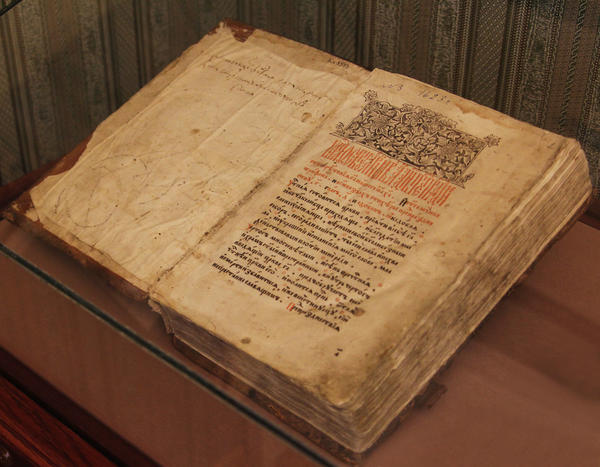Menaions are church books containing texts of prayers that change during the so-called yearly liturgical circle. There are three types of menaions: a menaion for a particular month contains services conducted on church feasts during such a month which are arranged in accordance with the Menologion, while the General Menaions contain prayers dedicated to a certain type of saints. The Festal Menaion contain services conducted during the great feasts.
The February menaion presented at the exposition became part of the Kaluga Museum’s collection in 1954, when it was brought from the State Museum of the Borovsk District. It was printed in 1622 during the reign of Tsar Mikhail of Russia and Patriarch Filaret at the Moscow Print Yard. The book is printed on rag paper. Its text is a half-uncial script with a font that was performed in a slightly freer manner than the uncial writing (the oldest form of the Cyrillic alphabet). The half-uncial allowed the slope of lettering, various curved lines, use of abbreviations and details. This allowed calligraphers to produce texts faster and make them easier to read.
Researchers found the following inscription on the menaion’s cover: ‘This book is for the month of February and was presented as a gift to Prince Dmitry Mikhailovich Pozharsky’.
Prince Dmitry Pozharsky arrived in Borovsk in 1615 as ordered by the new tsar, Mikhail Feodorovich, to form an army of Kaluga boyar children (service class men) for a battle with Polish invaders. And when the glorious commander was very sick, he was brought to Kaluga, where he was taken care of.
In 1617, Polish troops invaded Kaluga again and seized Meshchovsk and Kozelsk as a result of fierce battles. Then, the people of Kaluga once again asked the tsar for help. Prince Pozharsky and his small squadron struggled their way to Kaluga through numerous Polish troops and arranged the defense of the city. The Poles joined forces near Tovarkovo and set off to attack Kaluga. Pozharsky met them on the banks of the Yachenka River, not far from the Laurentian Monastery, where fierce battles lasted all day long and resulted in heavy losses on both sides. Pozharsky won these battles, and the Poles had to retreat. Ten days later, they attacked again and this time at night, but the experienced commander, who placed strong outposts and guards around the city, lured the enemy close under the walls and defeated the Poles with a powerful attack. The Poles gave up their intention to seize Kaluga, and Pozharsky moved his troops to defend Borovsk, and later, Mozhaisk, as was ordered by the tsar.
The February menaion presented at the exposition became part of the Kaluga Museum’s collection in 1954, when it was brought from the State Museum of the Borovsk District. It was printed in 1622 during the reign of Tsar Mikhail of Russia and Patriarch Filaret at the Moscow Print Yard. The book is printed on rag paper. Its text is a half-uncial script with a font that was performed in a slightly freer manner than the uncial writing (the oldest form of the Cyrillic alphabet). The half-uncial allowed the slope of lettering, various curved lines, use of abbreviations and details. This allowed calligraphers to produce texts faster and make them easier to read.
Researchers found the following inscription on the menaion’s cover: ‘This book is for the month of February and was presented as a gift to Prince Dmitry Mikhailovich Pozharsky’.
Prince Dmitry Pozharsky arrived in Borovsk in 1615 as ordered by the new tsar, Mikhail Feodorovich, to form an army of Kaluga boyar children (service class men) for a battle with Polish invaders. And when the glorious commander was very sick, he was brought to Kaluga, where he was taken care of.
In 1617, Polish troops invaded Kaluga again and seized Meshchovsk and Kozelsk as a result of fierce battles. Then, the people of Kaluga once again asked the tsar for help. Prince Pozharsky and his small squadron struggled their way to Kaluga through numerous Polish troops and arranged the defense of the city. The Poles joined forces near Tovarkovo and set off to attack Kaluga. Pozharsky met them on the banks of the Yachenka River, not far from the Laurentian Monastery, where fierce battles lasted all day long and resulted in heavy losses on both sides. Pozharsky won these battles, and the Poles had to retreat. Ten days later, they attacked again and this time at night, but the experienced commander, who placed strong outposts and guards around the city, lured the enemy close under the walls and defeated the Poles with a powerful attack. The Poles gave up their intention to seize Kaluga, and Pozharsky moved his troops to defend Borovsk, and later, Mozhaisk, as was ordered by the tsar.



